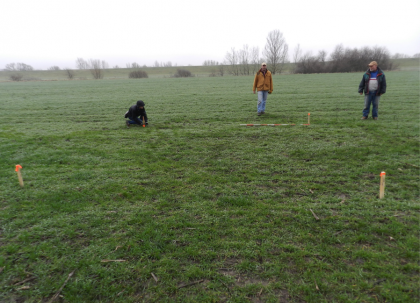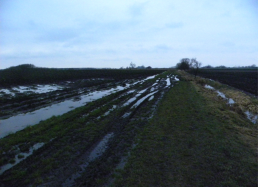1. "Megkísértsük a szerencsénket?" (Are we pressing our luck?)
This is the third day of field work. I arrived last Friday and worked with Attila and Dani to set up the field base on Saturday and Sunday—we moved all the equipment and the finds from the museum storage unit in Békéscsaba to Vésztő.
The rest of the team was supposed to arrive on Sunday, but several of the students from the U.S. had bad flight delays and cancellations. Three students got stuck in Newark for the night, and two got as far as Budapest but were too late to catch the last train to Békéscsaba. By Wednesday afternoon, however, we were full force and everyone was settled in with all their luggage in-hand.
It has been raining a lot in recent weeks, so we hope we aren’t pressing our luck by starting the season a little earlier this year. In previous years, the weather has been awesome, despite the fact that we're working in a temperate climate in the spring.
We managed to get out to the site on Sunday, undeterred by quite a bit of mud (see Photo #1 below, and check out our "Muddin' Video.") On Monday, we re-established our grid utilizing the GPS, and then we used a hand core to test several of the areas we were considering for excavation.
On Tuesday, we laid in the excavation trenches. In addition to re-opening the 10x10-meter northern block (N1B1) over the southern portion of the large and well preserved longhouse, we also added a 12x12-meter block to the northwest to expose the rest of the house.
We also decided to put a 5x5-meter unit in the southwestern part of the site (Block S1B2), in a part of the settlement that had been more intensively occupied. The third unit is a 5x5-meter block that is located in the westernmost part of the site and situated on top of a longhouse feature we identified using geophysics last year.
The weather held until yesterday afternoon. We were able to get all the units started and begin identifying features at the base of the plowzone. But yesterday, a big storm—complete with hail, lightning, and thunder—hit in the afternoon and the temperature dropped. It rained all night and we weren't able to get out in the field today.
We're using this time as an opportunity to catch up on lab work. The forecast says that the temperature is going to continue to drop to about 10 degrees tomorrow, but even if the mud freezes enough for us to get out into the field, we run the risk of it melting into slop while we're out there, which means we might get stuck when we try to return home at the end of the day.
More soon (I hope!)
Bill





